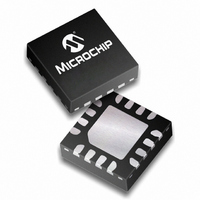PIC16F616-H/ML Microchip Technology, PIC16F616-H/ML Datasheet - Page 14

PIC16F616-H/ML
Manufacturer Part Number
PIC16F616-H/ML
Description
1.75KB Flash, 64B RAM, 6 I/O, 8MHz Internal Oscillator 16 QFN 4x4mm TUBE
Manufacturer
Microchip Technology
Series
PIC® 16Fr
Datasheets
1.PIC16F616T-ISL.pdf
(4 pages)
2.PIC16F616T-ISL.pdf
(214 pages)
3.PIC16F616T-ISL.pdf
(8 pages)
Specifications of PIC16F616-H/ML
Core Processor
PIC
Core Size
8-Bit
Speed
20MHz
Peripherals
Brown-out Detect/Reset, POR, PWM, WDT
Number Of I /o
11
Program Memory Size
3.5KB (2K x 14)
Program Memory Type
FLASH
Ram Size
128 x 8
Voltage - Supply (vcc/vdd)
2 V ~ 5.5 V
Data Converters
A/D 8x10b
Oscillator Type
Internal
Operating Temperature
-40°C ~ 150°C
Package / Case
16-QFN
Lead Free Status / RoHS Status
Lead free / RoHS Compliant
Eeprom Size
-
Connectivity
-
Lead Free Status / RoHS Status
Lead free / RoHS Compliant
- Current page: 14 of 214
- Download datasheet (4Mb)
PIC16F610/616/16HV610/616
2.2
The data memory (see Figure 2-4) is partitioned into
two banks, which contain the General Purpose
Registers (GPR) and the Special Function Registers
(SFR). The Special Function Registers are located in
the
PIC16F610/16HV610 Register locations 40h-7Fh in
Bank 0 are General Purpose Registers, implemented
as
locations 20h-7Fh in Bank 0 and A0h-BFh in Bank 1
are General Purpose Registers, implemented as static
RAM. Register locations F0h-FFh in Bank 1 point to
addresses 70h-7Fh in Bank 0. All other RAM is
unimplemented and returns ‘0’ when read. The RP0 bit
of the STATUS register is the bank select bit.
RP0
DS41288F-page 14
0
1
Note:
static
→
→
first
Data Memory Organization
Bank 0 is selected
Bank 1 is selected
The IRP and RP1 bits of the STATUS
register are reserved and should always be
maintained as ‘0’s.
RAM.
32
locations
PIC16F616/16HV616
of
each
Register
bank.
2.2.1
The register file is organized as 64 x 8 in the
PIC16F610/16HV610
PIC16F616/16HV616. Each register is accessed,
either directly or indirectly, through the File Select Reg-
ister (FSR) (see Section 2.4 “Indirect Addressing,
INDF and FSR Registers”).
2.2.2
The Special Function Registers are registers used by
the CPU and peripheral functions for controlling the
desired operation of the device (see Table 2-1). These
registers are static RAM.
The special registers can be classified into two sets:
core and peripheral. The Special Function Registers
associated with the “core” are described in this section.
Those related to the operation of the peripheral features
are described in the section of that peripheral feature.
GENERAL PURPOSE REGISTER
FILE
SPECIAL FUNCTION REGISTERS
© 2009 Microchip Technology Inc.
and
128 x 8
in
the
Related parts for PIC16F616-H/ML
Image
Part Number
Description
Manufacturer
Datasheet
Request
R

Part Number:
Description:
IC PIC MCU FLASH 2KX14 14SOIC
Manufacturer:
Microchip Technology
Datasheet:

Part Number:
Description:
IC PIC MCU FLASH 2KX14 16QFN
Manufacturer:
Microchip Technology
Datasheet:

Part Number:
Description:
IC PIC MCU FLASH 2KX14 14TSSOP
Manufacturer:
Microchip Technology
Datasheet:

Part Number:
Description:
IC PIC MCU FLASH 2KX14 14DIP
Manufacturer:
Microchip Technology
Datasheet:

Part Number:
Description:
IC PIC MCU FLASH 2KX14 14TSSOP
Manufacturer:
Microchip Technology
Datasheet:

Part Number:
Description:
1.75KB Flash, 64B RAM, 6 I/O, 8MHz Internal Oscillator 14 TSSOP 4.4mm TUBE
Manufacturer:
Microchip Technology
Datasheet:

Part Number:
Description:
IC PIC MCU FLASH 2KX14 14SOIC
Manufacturer:
Microchip Technology
Datasheet:

Part Number:
Description:
IC PIC MCU FLASH 2KX14 14DIP
Manufacturer:
Microchip Technology
Datasheet:

Part Number:
Description:
1.75KB Flash, 64B RAM, 6 I/O, 8MHz Internal Oscillator 16 QFN 4x4mm TUBE
Manufacturer:
Microchip Technology
Datasheet:

Part Number:
Description:
1.75KB Flash, 64B RAM, 6 I/O, 8MHz Internal Oscillator 14 SOIC .150in TUBE
Manufacturer:
Microchip Technology
Datasheet:

Part Number:
Description:
14-pin Flash-based, 8-bit Cmos Microcontrollers
Manufacturer:
Microchip Technology Inc.
Datasheet:

Part Number:
Description:
IC, 8BIT MCU, PIC16F, 32MHZ, SOIC-18
Manufacturer:
Microchip Technology
Datasheet:

Part Number:
Description:
IC, 8BIT MCU, PIC16F, 32MHZ, SSOP-20
Manufacturer:
Microchip Technology
Datasheet:

Part Number:
Description:
IC, 8BIT MCU, PIC16F, 32MHZ, DIP-18
Manufacturer:
Microchip Technology
Datasheet:

Part Number:
Description:
IC, 8BIT MCU, PIC16F, 32MHZ, QFN-28
Manufacturer:
Microchip Technology
Datasheet:










